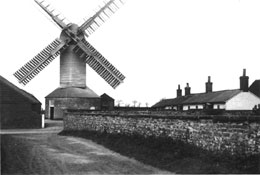
![]()
|
A
brief history of the mill It seems a Mill has stood on this site since at least 1688 and possibly considerably longer, certainly the high ground overlooking the river catches the wind to provide ample amounts of motive power. This particular post mill with brick roundhouse and wooden sails was constructed in 1797/8 by Thomas Butcher of Wickham Market for William Ship and John Hunt of nearby Parham at a cost of £210. It seems William Ship died in the very early 1800's because all the remaining documents are in the name of Mary Ship and bear her mark in the form of a cross until she disappears from the documentation in 1855. Following this short history is a list of the documents still surviving which includes leases, sub leases and mortgages (in those days arranged from private individuals and formalised at the Courts Baron for the Manor of Snape). There are also some receipted solicitors' invoices from the late 1800's when the daily fee seemed to be around two to three guineas and the railway fare from Saxmundham to Wenhaston 2/6d, (this would have been travelled partly on the old Southwold Railway, closed in 1929). The modest miller's cottage and granary were constructed at the same time and a Norwich Union fire insurance policy exists dated 1801 which insures the windmill, working gear, granary, stock and "his new dwelling house and chattels" at £550 for an annual premium of one guinea. Interestingly another policy dated 1884, when additional buildings had been constructed, shows a sum insured of £500 for an annual premium of £1 16s 4d. The mill worked through various owners producing fine white flour and, in the middle of the 19th century, was also used for the grinding of coprolite, a phosphate rich material found under the abundant crag deposits locally, to produce an artificial manure. The material was discovered by Edward Packard a Saxmundham chemist who subsequently built his own mill near Ipswich and went on to become a founder member of Fisons. In 1897 the mill was purchased by Harry Hudson from the widow of Joseph Lee, he worked the mill until he sold it in 1925 and, since that time, it was known as Hudson's Mill. There were two other mills in Snape, Markins mill, with an open trestle bottom and cloth sails, in Sandy Lane producing brown flour, built in 1800 and demolished in 1922, and a smaller cloth sail mill somewhere on the track from Sandy Lane to Blackheath Mansion used for turning a wood lathe. With competition from mechanised roller mills increasing, the traditional millers were finding life difficult and it seems, in common with many other windmills, the sails were removed and an oil engine was installed to provide more constant motive power to drive the stones. This was not sufficient to save the mill and grinding ceased in 1933. The buck was later dismantled by John Brown of Leiston but the stones were stored in the roundhouse until 1936 when the runner (upper) stone was taken to Saxtead Mill. This mill is preserved by English Heritage and is open to the public. In 1937 the mill and outbuildings were purchased by Benjamin Britten and converted into a house. The conversion is described in 'The Britten Years' section of the website. Britten moved to Aldeburgh in 1947 and let The Old Mill initially to a Mrs June Billows for a monthly rent of £8 6s 8d. Other tenants resided in the property until 1955 when Britten sold it to Mr and Mrs Philip Terry as a holiday home. Mr Terry was a solicitor with a London firm while Mrs Phyllis Terry nee Whiteman was an artist who illustrated children's books. Up until 1970 the Old Mill was used as a holiday home or let to various people including some teachers stationed at the nearby American air force base, RAF Bentwaters. The Terrys retired to permanent occupation in 1970 until Mrs Terry died in 1998 after surviving her husband by some eight years. The Old Mill was purchased in August 1999 by Jane and Roger Horton and very extensive renovations and refurbishment were carried out. See
other history files |
See
other history files
|
